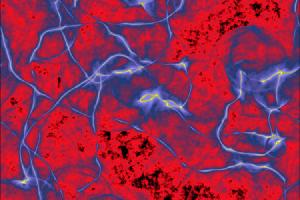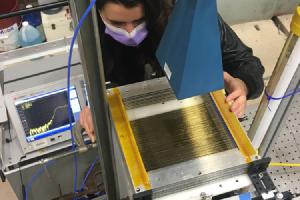Blog
A Shot in the Dark
14 March 2022
If dark matter is out there, and it certainly seems to be, then what could it possibly be? That is perhaps the biggest mystery of dark matter. The only known particles that match the requirement of having mass and not interacting strongly with light are neutrinos. But neutrinos have low mass and zip through the cosmos at nearly the speed of light. They are a form of “hot” dark matter, so they don’t match the observed data that require dark matter to be “cold.” With neutrinos ruled out, cosmologists look toward various hypothetical particles we haven’t discovered, and perhaps the most popular of these are known as axions.
Axions were first proposed in the 1970s as a way to address certain issues in our understanding of the strong nuclear force. According to the theories, axions should be massive particles that weakly interact with light. Depending on the proposed mass of these particles, they could be a solution to the dark matter problem. Unfortunately, the data we’ve gathered keeps ruling out axion models. Measurements of nuclear spin rule out many of the models, and spectral observations rule out others. There are several ways to tweak axion models, but experiments specifically trying to detect axions have come up with nothing. Now a new experiment might explain why.1
 Malte Buschmann, Princeton University
Malte Buschmann, Princeton UniversityRather than trying to observe axions experimentally, this latest work uses computer models to simulate early moments of the universe. Using a method known as adaptive mesh refinement, the team was able to simulate regions of the early universe in higher detail than before. They found that soon after the inflationary period there are string-like vortices that can fling axion particles into less dense areas. By comparing their models with the observed clustering scale of galaxies, they could predict the mass of axions. The uncertainty of their mass value is large, but it is a range more than twice as massive as we’ve thought.
This could explain why previous axion searches have failed. Most axion experiments try to detect axions by measuring their interaction with magnetic fields. For example, a resonant cavity with a strong magnetic field should jostle any axion passing through it. The axion would then emit an electromagnetic flash we could detect. But this type of experiment only works for less massive axions around 20 - 30 micro electron volts. This new study predicts axions are closer to 65 micro electron volts, meaning they are too massive for previous experiments to see. So perhaps axions do exist, but we’ve been looking in the wrong mass range.
 Karl van Bibber
Karl van BibberThe team goes on to look at how more massive axions might be detected. One possibility is known as a plasmonic haloscope, which is a three-dimensional array of fine wires used to create a plasma metamaterial. Heavier axions should interact with the metamaterial in detectable ways. But this type of experiment is still a long way off.
Axions are not the only possible solution to dark matter, so even if they are ruled out in the end there are other hypothetical options. And as this latest study shows, the disappointing axion results we’ve had so far might not be the bummer we’ve thought. Looking for axions in a higher mass range is certainly worth a shot in the dark.
Buschmann, Malte, et al. “Dark matter from axion strings with adaptive mesh refinement.” Nature Communications 13.1 (2022): 1-10. ↩︎